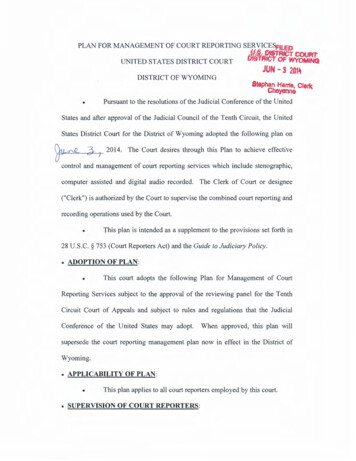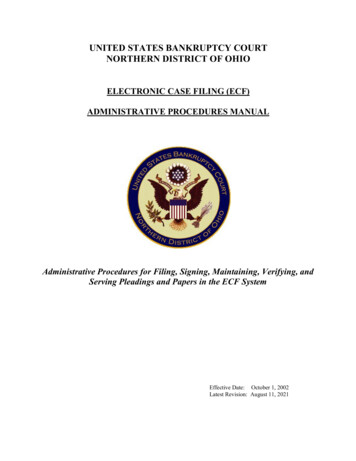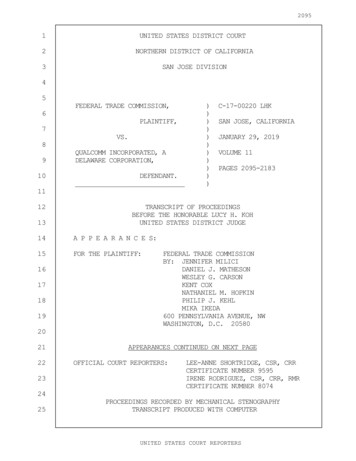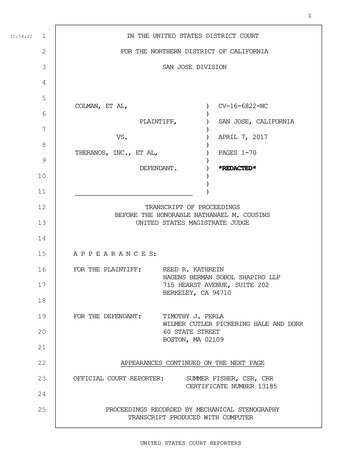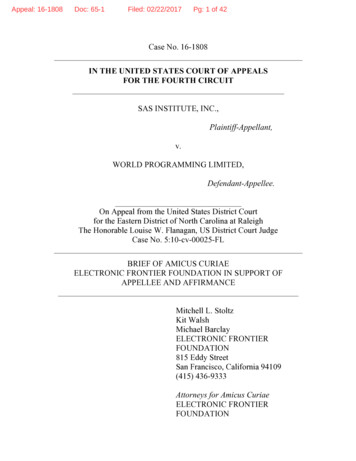
Transcription
Appeal: 16-1808Doc: 65-1Filed: 02/22/2017Pg: 1 of 42Case No. 16-1808IN THE UNITED STATES COURT OF APPEALSFOR THE FOURTH CIRCUITSAS INSTITUTE, INC.,Plaintiff-Appellant,v.WORLD PROGRAMMING LIMITED,Defendant-Appellee.On Appeal from the United States District Courtfor the Eastern District of North Carolina at RaleighThe Honorable Louise W. Flanagan, US District Court JudgeCase No. 5:10-cv-00025-FLBRIEF OF AMICUS CURIAEELECTRONIC FRONTIER FOUNDATION IN SUPPORT OFAPPELLEE AND AFFIRMANCEMitchell L. StoltzKit WalshMichael BarclayELECTRONIC FRONTIERFOUNDATION815 Eddy StreetSan Francisco, California 94109(415) 436-9333Attorneys for Amicus CuriaeELECTRONIC FRONTIERFOUNDATION
Appeal: 16-1808Doc: 65-1Filed: 02/22/2017Pg: 2 of 42CORPORATE DISCLOSURE STATEMENTPursuant to Rule 26.1 of the Federal Rules of Appellate Procedure,amicus curiae Electronic Frontier Foundation states that it does not have aparent corporation, and that no publicly held corporation owns 10% or moreof the stock of amicus.i
Appeal: 16-1808Doc: 65-1Filed: 02/22/2017Pg: 3 of 42TABLE OF CONTENTSCORPORATE DISCLOSURE STATEMENT . iTABLE OF AUTHORITIES. ivSTATEMENT OF IDENTITY AND INTEREST OF AMICUS CURIAE . 1INTRODUCTION AND SUMMARY OF ARGUMENT . 1ARGUMENT . 4I.Decades of Consistent Court Opinions Set Settled Expectations ThatCopyright Law Allows for Interoperability . 4A.Copyright Law Favors Interoperability by ExcludingFunctionality from the Scope of Its Limited Monopoly . 4B.Oracle v. Google Was Wrongly Decided and ThreatensInnovation and Competition. 7II.Interfaces, Including Compilers and Interpreters, Provide BasicMethods of Operation Among Computers, Programs, and Humans . 9A.The SAS Compiler/Interpreter Is an Interface to Translate InputValues into Specific Outputs. 9B.Copyright Protection for Interfaces Like the SASInterpreter/Compiler Would Stifle Competition and Innovation . 11III.Re-Implementation of Interfaces Was Essential to the Development ofModern Computers and the Internet . 13A.The BIOS of the Original IBM-Compatible PC . 13B.Major Modern Operating Systems Reimplement theGroundbreaking UNIX Interface . 16C.The C Programming Language Became Universal Because of ItsUncopyrightable Interface. 18D.Treating Interfaces as Copyrightable Would Undermine theIndustry Standards for Cloud Computing . 20E.Uncopyrightable Interfaces Spur the Creation of Software ThatOtherwise Would Not Be Written . 23ii
Appeal: 16-1808Doc: 65-1F.Filed: 02/22/2017Pg: 4 of 42Copyright in Interfaces Would Create an “Orphan Software”Problem . 26CONCLUSION . 31CERTIFICATE OF COMPLIANCE . 32CERTIFICATE OF SERVICE . 33iii
Appeal: 16-1808Doc: 65-1Filed: 02/22/2017Pg: 5 of 42TABLE OF AUTHORITIESCasesBaker v. Selden,101 U.S. 99 (1880) . 4, 5Bateman v. Mnemonics, Inc.,79 F.3d 1532 (11th Cir. 1996) . 6Baystate Technologies, Inc. v. Bentley Systems, Inc.,946 F. Supp. 1079 (D. Mass. 1996) . 6Bikram’s Yoga College of India, L.P. v. Evolation Yoga, LLC,803 F.3d 1032 (9th Cir. 2015 . 7Gates Rubber Co. v. Bando Chem. Indus., Ltd.,9 F.3d 823 (10th Cir. 1993) . 6Lotus Dev. Corp. v. Borland Int’l, Inc.,49 F.3d 807 (1st Cir. 1995) . 5, 11, 12, 15Lotus Dev. Corp. v. Borland Int’l, Inc.,516 U.S. 233 (1996) . 5MiTek Holdings, Inc. v. Arce Engineering Co.,89 F.3d 1548 (11th Cir. 1996) . 5Mitel, Inc. v. Iqtel, Inc.,896 F. Supp. 1050 (D. Colo. 1995) . 6Mitel, Inc. v. Iqtel, Inc.,124 F.3d 1366 (10th Cir. 1997). . 7Oracle v. Google,750 F.3d 1339 (Fed. Cir. 2014) . 7Paterson v. Little, Brown & Co.,502 F. Supp. 2d 1124 (W.D. Wash. 2007) . 17Sega Enters., Ltd., v. Accolade, Inc.,977 F.2d 1510 (9th Cir. 1992) . 6iv
Appeal: 16-1808Doc: 65-1Filed: 02/22/2017Pg: 6 of 42Sony Computer Ent’mt, Inc. v. Connectix Corp.,203 F.3d 596 (9th Cir. 2000) . 6Whelan Associates, Inc. v. Jaslow Dental Laboratory, Inc.,797 F.2d 1222 (3d Cir. 1986) . 7Statutes17 U.S.C. § 102 . passimOther AuthoritiesA Tour of Pinboard, Pinboard, -it-all-go-so-wrong . 28About Wine, WineHQ, http://www.winehq.org/about/. 24Amazon Web Services (AWS) and Eucalyptus Partner to Bring AdditionalCompatibility Between AWS and On-Premises IT Environments, Eucalyptus(March 22, 2012), -andeucalyptus-partner . 21BLAS Frequently Asked Questions, Netlib (Jul. 25, 2005),http://www.netlib.org/blas/faq.html . 25Bobbie Johnson, Oh, Delicious—Where Did It All Go So Wrong?, GigaOm(Sept. 28, 2011) . 27, 28Brian W. Kernighan & Dennis M. Ritchie, The C Programming Language(1978) . 19Business Applications, Amazon Web Services, http://aws.amazon.com/businessapplications . 21C Run-Time Libraries, Microsoft Developer x4dbyh(v vs.80).aspx . 19Charles H. Ferguson & Charles R. Morris, Computer Wars: The Fall of IBMand the Future of Global Technology (1994) . 13, 14, 15Compaq Computer Corporation: Portable Computer, Encyclopedia -Computer-Corporation . 15v
Appeal: 16-1808Doc: 65-1Filed: 02/22/2017Pg: 7 of 42David Pogue, Google’s Aggregator Gives Way to an Heir, N.Y. Times (May 8,2013), ogle-reader.html? r 1& . 30Erick Schonfeld, The Top 21 Twitter Clients, TechCrunch (Feb. 19, twitter-clients-according-totwitstat . 29Flipboard, Flipboard . 29Heather J. Meeker, The Open Source Alternative (2008). 16, 17How It Works, Sickweather, http://www.sickweather.com/how . 29IBM, Basic Linear Algebra Subprograms Library Programmer’s Guide and APIReference (2008), http://webpages.uncc.edu/ apanday/documents/BLAS Prog Guide API v3.0.0.3.pdf . 25Ingrid Marson, Microsoft Admits Targeting Wine Users, ZDnet(Feb. 25, 2005), neusers-3039189180/ . 24Jeff Tyson, How BIOS Works, HowStuffWorks . 14John McDermott, App Developers Shun Microsoft’s Surface, Ad Age (Dec. 4,2012), un-microsoft-ssurface/238602/ . 29John Villasenor, How Much Copyright Protection Should Source Code Get? ANew Court Ruling Reshapes The Landscape, Forbes (May 19, pe/ . 9Jonathan Band, The Federal Circuit’s Poorly Reasoned Decision in Oracle v.Google, Disco (May 9, 2014), on-in-oracle-vgoogle . 8Kin Lane, Where Will Your API Stand In The Oracle v Google API CopyrightDebate?, API Evangelist (May 10, ght-debate/ . 8vi
Appeal: 16-1808Doc: 65-1Filed: 02/22/2017Pg: 8 of 42Kristina Dell, Entrepreneurs Who Go It Alone—By Choice, Time (Oct. 24,2011), icle/0,28804,2094921 2094923 2094924,00.html . 28Margaret Rouse, Definition: Virtual Machine (VM), SearchServerVirtualization(Oct. 2011), efinition/virtualmachine . 20, 21Matthew Schwartz, Reverse Engineering, Computerworld (November 12, /app-development/reverseengineering.html. 14Microsoft Dictionary (2005) . 13Milestones in AT&T History, .html . 16National Research Council, The Future of Supercomputing: An Interim Report(2003) . 25, 26Netmarketshare, Mobile/Tablet Operating System Market stem-market-share.aspx?qprid 8&qpcustomd 1&qptimeframe M . 18Operating System Development Over Time, TOP500 Supercomputer List,http://www.top500.org/statistics/overtime/ . 18Salvador Rodriguez, Google Reader’s demise means big gains for Feedly, LosAngeles Times (March 18, 2013), tory 30SAS, Introduction to SAS Informats and haps/59498.pdf . 10Scheduling Policies and Limits, Ohio Supercomputer ocessing-at-osc/schedulingpolicies-and-limits . 25Scott Swigart & Sean Campbell, Interview with Alexandre Juliard, Head of theWine Project/CTO of CodeWeavers, How Software is Built (Sept. 8, -of-CodeWeavers/ . 24vii
Appeal: 16-1808Doc: 65-1Filed: 02/22/2017Pg: 9 of 42Stephen Satchell, The Corona ATP is Faster than the IBM PC AT, But it HasFlaws, InfoWorld (Jan. 1986) . 14Steven J. Vaughan-Nichols, How Many Linux Users Are There (Really)?Linux Planet (Feb. 18, 2009), 1/1 . 17, 18Steven J. Vaughan-Nichols, OpenStack vs. CloudStack: The Beginning of theOpen-Source Cloud Wars, ZDNet (Apr. 12, cloud-wars/10763 . 22The GNU C Library (glibc), The GNU Project,http://www.gnu.org/software/libc/ . 19The Native Android API, Mobile Pearls, : http://mobilepearls.com/labs/nativeandroid-api/ . 19Timothy B. Lee, The Court That Created the Patent Troll Mess Is Screwing UpCopyright Too, Vox (May 9, 2014), ision-is-a-disaster-for-the-software-industry . 8Usage of operating systems for websites, perating system/all. 18Usage statistics and market share of Unix for websites, s-linux/all/all . 18Van Lindberg, Intellectual Property and Open Source: A Practical Guide toProtecting Code (2008) . 14, 15What is Cloud Computing?, Amazon Web Services,http://aws.amazon.com/what-is-aws . 20viii
Appeal: 16-1808Doc: 65-1Filed: 02/22/2017Pg: 10 of 42STATEMENT OF IDENTITY AND INTEREST OF AMICUS CURIAE1The Electronic Frontier Foundation (EFF) is a nonprofit civil libertiesorganization that works to ensure that new technologies advance the freedom ofits users rather than compromising it. EFF has over 36,000 dues-payingmembers, and represents the interests of computer scientists and users oftechnology who have relied on decades of custom and precedent that recognizedthe importance of interoperability. That custom and precedent has also permittedsoftware engineers to reimplement the functionality of interfaces likeinterpreter/compilers and methods of operation embodied in software. Thepublic depends on and expects the inherent openness of interfaces to supportinnovation by startups and incumbents alike. The Court should decline SAS’sinvitation to undermine those settled expectations.INTRODUCTION AND SUMMARY OF ARGUMENTFor decades, computer scientists have relied on the freedom toreimplement software functions to enable rapid innovation in computertechnology. For decades, circuit courts have supported that reliance, concludingthat Section 102(b) of the Copyright Act protects a programmer’s source code as1No counsel for a party authored this brief in whole or in part, and no suchcounsel or party made a monetary contribution intended to fund the preparationor submission of this brief. No person other than the amicus curiae, or itscounsel, made a monetary contribution intended to fund its preparation orsubmission. Both parties have consented to the filing of this brief.Websites cited in this brief were last visited on February 15, 2017.1
Appeal: 16-1808Doc: 65-1Filed: 02/22/2017Pg: 11 of 42creative expression, but does not cover the processes, systems, and methods ofoperation that code may employ to interface with other software. The districtcourt correctly followed that precedent and rejected SAS’s claim that copyrightlaw grants it a monopoly over the functional input and output behavior of itsinterpreter/compiler.If SAS’s view had been accepted at the birth of modern computing, manyimportant technologies would never have existed or succeeded. For example, thewidespread availability of diverse, cheap, and customizable personal computersowes its existence to the lack of copyright on the specification for IBM’s BasicInput/Output System (BIOS) for the PC. And interoperability was essential tomany modern computing developments, including those of operating systemssuch as UNIX, programming languages such as “C,” the Internet’s networkprotocols, and cloud computing.Today, open, uncopyrightable interfaces continue to spur the creation andadoption of new technologies. When programmers can freely reimplement orreverse engineer functional interfaces without obtaining a costly license orrisking a lawsuit, they can create compatible software that the interface’soriginal creator might never have envisioned or had the resources to develop.Moreover, compatible software helps enable people to switch platforms andservices freely, and to find software that meets their needs regardless of what2
Appeal: 16-1808Doc: 65-1Filed: 02/22/2017Pg: 12 of 42browser or operating system they use. Without the compatibility enabled by theopen nature of interfaces, customers could be forced to leave their data andprograms behind when they switch to a new service.The freedom to reimplement software functionality also helps developersrescue “orphan” software or data—systems that are no longer supported by theircreators. When a company stops supporting a computer platform or service, theability to freely reimplement interfaces protects the communities that rely onthat software. Government entities and non-profits are especially susceptible tothe orphan programs problem as they often cannot afford to upgrade and are leftusing legacy technologies for years or decades.SAS seeks an unprecedented and dangerous power over the future ofinnovation. Software creators would have veto rights over any developer whowants to create a compatible program—regardless of whether they copy anyliteral code from the original implementation. That, in turn, would upset thesettled business practices that have enabled the American computer industry toflourish, and choke off many of the system’s benefits to customers.We urge this Court to protect software innovation by affirming the districtcourt’s conclusion that WPL did not copy any copyrightable element of SAS’ssoftware.3
Appeal: 16-1808Doc: 65-1Filed: 02/22/2017Pg: 13 of 42ARGUMENTI.DECADES OF CONSISTENT COURT OPINIONS SET SETTLED EXPECTATIONSTHAT COPYRIGHT LAW ALLOWS FOR INTEROPERABILITYA.Copyright Law Favors Interoperability by ExcludingFunctionality from the Scope of Its Limited MonopolyDecades of progress and innovation in computer technology havedepended upon the open nature of functional specifications, such as thefunctionality of an interpreter/compiler that allows a human being to input“scripts” written in a programming language, and generate particular computerbehavior such as rendering a graph, executing computations, or storing data inmemory. The free and open use of such specifications and programminglanguages has been both routine and essential in the computer industry since itsbeginning, and that use depended, in turn, on the sensible assumption thatfunctional behavior of software is uncopyrightable.That assumption is deeply grounded in caselaw. SAS makes claims thatare remarkably similar to those rejected by the Supreme Court over 100 yearsago in Baker v. Selden, 101 U.S. 99 (1880). Selden’s treatise described severalaccounting methods, and contained special ledger formats tied to those methods.He claimed that his copyright in the treatise allowed him to exclude others fromusing those ledger formats and the methods described in the text. Id. at 101. TheSupreme Court rejected this claim:4
Appeal: 16-1808Doc: 65-1Filed: 02/22/2017Pg: 14 of 42[T]here is a clear distinction between the book, as such, and theart which it is intended to illustrate. To give to the author of thebook an exclusive property in the art described therein, when noexamination of its novelty has ever been officially made, wouldbe a surprise and a fraud upon the public. That is the provinceof letters-patent, not of copyright. The claim to an invention ordiscovery of an art or manufacture must be subjected to theexamination of the Patent Office before an exclusive righttherein can be obtained; and it can only be secured by a patentfrom the government.Id. at 102. The ledger formats were a part of the uncopyrightable system ofaccounting described in Selden’s work. They were not copyrightable expression.Applying that principle to software, the influential Lotus case recognizedthat menu hierarchies that control functional capabilities are a method ofoperation, and thus uncopyrightable under 17 U.S.C. § 102(b). Lotus Dev. Corp.v. Borland Int’l, Inc., 49 F.3d 807, 815 (1st Cir. 1995), aff’d by an equallydivided Court, 516 U.S. 233 (1996); see also MiTek Holdings, Inc. v. ArceEngineering Co., 89 F.3d 1548, 1556-57 (11th Cir. 1996) (input structure ofmenu was uncopyrightable system under §102(b)). Programmers and developersrelied on such rulings for the proposition that functional interfaces, mappinginputs to particular behaviors like the menu hierarchy in Lotus, may not becopyrighted under § 102(b).Similarly, the Ninth Circuit explained that the “functional requirementsfor compatibility” between computer programs “are not protected by copyright.”5
Appeal: 16-1808Doc: 65-1Filed: 02/22/2017Pg: 15 of 42Sega Enters., Ltd., v. Accolade, Inc., 977 F.2d 1510, 1522 (9th Cir. 1992); seealso Sony Computer Ent’mt, Inc. v. Connectix Corp., 203 F.3d 596, 599–600(9th Cir. 2000) (describing Sony’s PlayStation BIOS as a “system interfaceprocedure[]” that Connectix was entitled to reimplement under § 102(b)). Inboth cases, competitors reverse engineered the functional input/output profilesof video game software to allow original games to be run on existing videogame consoles. The competitors needed to understand what inputs generatedcorresponding outputs in order to create competing works, and copyright lawpermitted them to copy these elements.Courts across the country have followed suit, repeatedly holding that theuse of functional elements and formats does not infringe copyright. E.g.,Bateman v. Mnemonics, Inc., 79 F.3d 1532, 1547 (11th Cir. 1996) (need forfunctional compatibility can negate infringement claim); Gates Rubber Co. v.Bando Chem. Indus., Ltd., 9 F.3d 823, 843–44 (10th Cir. 1993) (functionalityand processes not copyrightable); Baystate Technologies, Inc. v. BentleySystems, Inc., 946 F. Supp. 1079, 1087–88 (D. Mass. 1996), appeal docketed,Nos. 97–1077, 97–1227 (1st Cir. Jan. 17, 1997, Feb. 28, 1997) (data structuresnot protected by copyright); Mitel, Inc. v. Iqtel, Inc., 896 F. Supp. 1050 (D.Colo. 1995) (telephone input command codes were an uncopyrightable"procedure, process, system, and method of operation"), aff’d on different6
Appeal: 16-1808Doc: 65-1Filed: 02/22/2017Pg: 16 of 42grounds, 124 F.3d 1366 (10th Cir. 1997).B.Oracle v. Google Was Wrongly Decided and ThreatensInnovation and CompetitionThe Federal Circuit’s decision in Oracle v. Google, 750 F.3d 1339 (Fed.Cir. 2014), was a disturbing outlier from modern interoperability precedent anda misstatement of the law of the Ninth Circuit. The Federal Circuit asserted that“an original work - even one that serves a function - is entitled to copyrightprotection as long as the author had multiple ways to express the underlyingidea.” Id. at 1367. This assertion resurrected reasoning from Whelan Associates,Inc. v. Jaslow Dental Laboratory, Inc., 797 F.2d 1222 (3d Cir. 1986), an earlycase that was broadly rejected within a decade of its issuance. Whelan held that“the purpose or function of a utilitarian work would be the work’s idea, andeverything that is not necessary to that purpose or function would be part of theexpression of the idea.” Id. at 1236.The Ninth Circuit itself noted in Sega that “[t]he Whelan rule . . . has beenwidely—and soundly—criticized as simplistic and overbroad,” 977 F.2d at1525. The Ninth Circuit implicitly rejected this reasoning again (after Oracle) inBikram’s Yoga College of India, L.P. v. Evolation Yoga, LLC, 803 F.3d 1032(9th Cir. 2015).Noting the industry’s long-standing reliance on cases mentioned above,one commenter explained why the Federal Circuit decision was so harmful:7
Appeal: 16-1808Doc: 65-1Filed: 02/22/2017Pg: 17 of 42By ruling that interoperability is relevant only to fair use, andnot to protectability, Judge O’Malley would require everydeveloper to perform a fair use analysis before developing aninteroperable product. This would place U.S. programmers at acompetitive disadvantage to developers in other jurisdictionsthat recognized that copyright does not protect programelements necessary for interoperability.Jonathan Band, The Federal Circuit’s Poorly Reasoned Decision in Oracle v.Google, DisCo (May 9, 2014).2Others pointed out flaws in the FederalCircuit’s reasoning, suggesting it reflected a “fundamental lack of understandingof how software works.” Timothy B. Lee, The Court That Created the PatentTroll Mess Is Screwing Up Copyright Too, Vox (May 9, 2014).3 One computerscientist analogized the computer industry’s economy to an engine, and statedthat “Oracle is replacing the engine oil with glue.” Kin Lane, Where Will YourAPI Stand In The Oracle v Google API Copyright Debate?, API Evangelist(May 10, 2014).4 Another technologist criticized the Federal Circuit for“creating a new class of copyright plaintiffs intent on using perceived structuralsimilarities in all manner of software products as grounds to demand copyrightroyalties.” John Villasenor, How Much Copyright Protection Should SourceCode Get? A New Court Ruling Reshapes The Landscape, Forbes (May 19,2Available at: on-in-oracle-v-google.3Available at: lable at: bate/.8
Appeal: 16-1808Doc: 65-1Filed: 02/22/2017Pg: 18 of 422014).5EFF urges the court to reject SAS’s invitation to embrace the FederalCircuit’s widely criticized and insupportable approach.II.INTERFACES, INCLUDING COMPILERS AND INTERPRETERS, PROVIDE BASICMETHODS OF OPERATION AMONG COMPUTERS, PROGRAMS, AND HUMANSConsidered in light of the overwhelming weight of case law, SAS’scopyright claim is both insupportable and dangerous. The technology that is thebasis of the copyright claim is nothing more than a basic and purely functionalinterface. Treating it as a form of copyrightable expression would undermineboth the letter and the purpose of copyright.A.The SAS Compiler/Interpreter Is an Interface to TranslateInput Values into Specific OutputsThe SAS compiler/interpreter is an interface for humans to operatecomputers using computer code. A human writes code in the SAS language andthen inputs it to the compiler/interpreter, which then processes the codeaccording to a method to generate particular computer behavior.On the input side, a programmer specifies a certain input format to tell thecomputer how to read in data. For instance, SAS supports input of calendardates in different lengths, such as 02/22/2017 versus 02/22/17. The programmer5Available at: e-get-a-new-court-rulingreshapes-the-landscape/.9
Appeal: 16-1808Doc: 65-1Filed: 02/22/2017Pg: 19 of 42specifies the input format so that the compiler/interpreter correctly interprets thedata to be processed. (For example, without the correct input formatspecification, the computer might interpret “02/22/17” as being in the year 17A.D., or perhaps 1917, instead of 2017.) The programmer likewise specifies viathe SAS Language what the computer should do with the data once it is input.SAS, Introduction to SAS Informats and Formats,6 2-3.The SAS compiler/interpreter can then generate a variety of computerbehavior. The programmer can command the computer to execute certainmathematical computations, ranging from simple addition to statistical analyses.It can display text and numbers in a variety of formats. For example, commandsmay be given to display numbers either in raw form, with commas, or withdollar signs (i.e., 2000; 2,000; or 2,000). Such output formats for displayingnumerical data have been commonplace for decades in the computer context 4-5.Thecompiler/interpreter is also capable of re
SAS INSTITUTE, INC., Plaintiff-Appellant, v. WORLD PROGRAMMING LIMITED, Defendant-Appellee. _ On Appeal from the United States District Court . Industry Standards for Cloud Computing . 20! E.! Uncopyrightable Interfaces Spur the Creation of Software That Otherwise Would Not Be .








